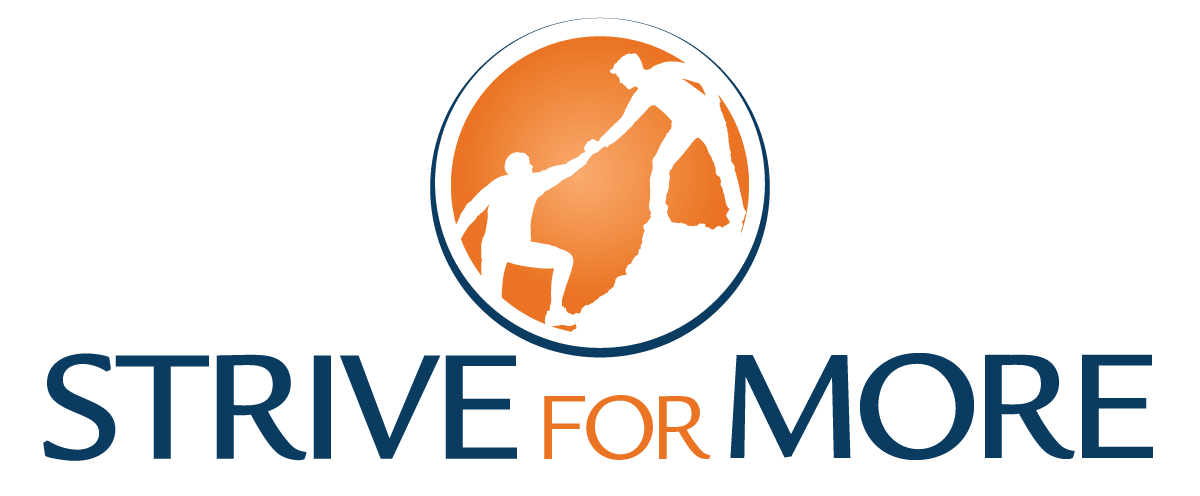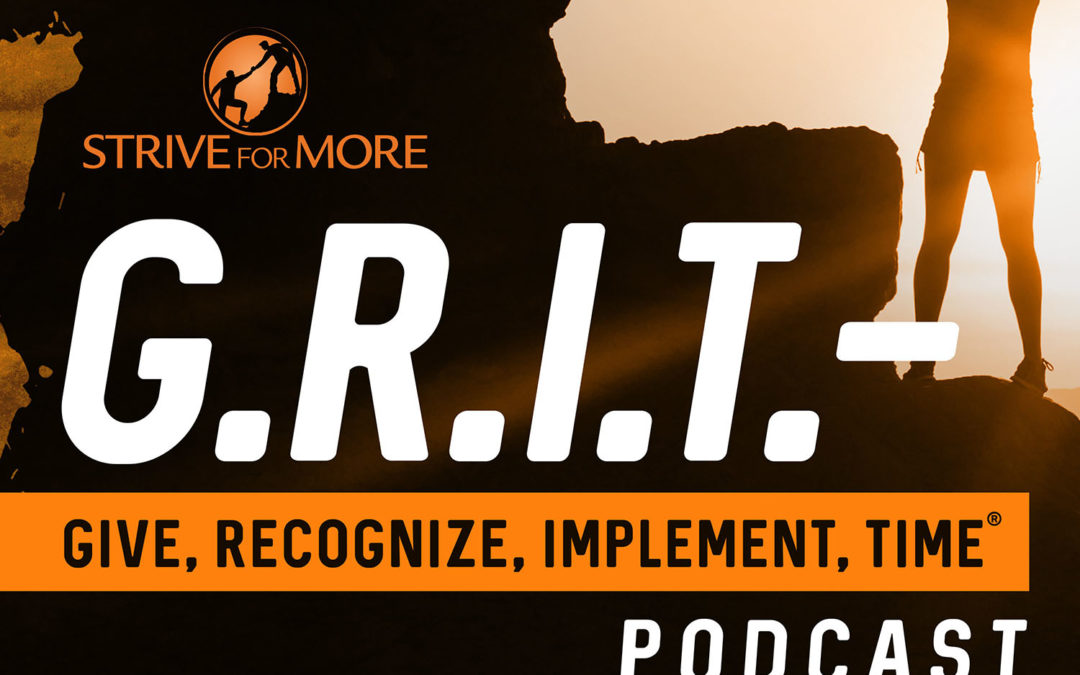Episode Transcript
Hello everybody and welcome back to another episode of the G.R.I.T. – Give, Recognize, Implement, Time® podcast. I’m your host, Steven Nathenson CEO & Founder of Strive For More. And today we’re going to tackle a very important question of how do I have difficult conversations. This is a very, very common question, especially in the work world when we have say a performance review that we are giving, that we need to give some feedback on, or we are expressing a difference in opinion, to perhaps a partner or a peer or even a leader. And then in life in general. I really have to have this conversation with somebody about lack of respect, or the way that they treat me or others. There’s a lot of different scenarios that this question is applicable to. So there’s three key things that I want to share with you today to help answer this question of how do I have difficult conversations. The first of which is on us. How are we going into that conversation?
How we go into it has a huge impact on how that conversation actually goes. Some of the most common things that can take us away from successfully having that conversation are the mood that we are in. Am I already upset and angry? Am I distracted from the day? Am I not all there? Am I perhaps hungry? Do I perhaps need to use the restroom? Are there things that distract me from truly fully being present and open during this conversation?
That’s what this first key is all about. How do we go into that conversation? That best sets us up for having it successfully and getting to where we want it to go. So a couple key tricks there are basic human needs. Am I hungry? Have I eaten? Do I have water or something to drink? And I have I done that? Do I to use the restroom? I share these because these can be often critical distractors. Being hangry is a real thing for a lot of us. So feeling properly, taking the time we need before that meeting to get our heads straight and to be calm, cool and collected is critical, because not only does it allow me to think more clearly for me and myself, but it also allows me to be more open and receptive to the other person or people in the conversation itself.
So I’ll throw out a quick trick for you. What do you need to be at your best? When you look at the conversations you’ve had that have gone really well and have been free flowing and open and collaborative and engaging, what led to it? What kind of mindset did you go into that conversation with? What did you do ahead of time to allow yourself to be in that type of mindset? Did you take a five minute quick break to prepare for the meeting, to get up, to walk around distress from anything else that’s perhaps come up throughout the day?
Is there a mantra you say to yourself? Is there meditation that you do? And one way to look at this is when you go into very important meeting, say an interview for a job, what do you do in those situations that allow you to best prepare to have that conversation? Those are the same kind of tricks we’re talking about here. [inaudible 00:03:40] we setting ourselves up for success, versus just hopping from one conversation to the next like we’re prone to do in this virtual world, hopping from meeting to meeting at the clickable button. So that’s the first key. How are we going into this conversation? What allows us to go in calm, cool, collected, and truly open and receptive in that conversation?
The second thing is also on this. What am I focusing on during the conversation? Am I focusing on what I need or what we collectively want to achieve? There is a difference. Judith Glaser who created Conversational Intelligence, talks a lot about getting to we. And it’s an important distinction because when we focus on I oriented language, what I need, what I have to convey, what I’m sharing and what my thoughts and opinions are, we’re very focused on us. And it closes us off to being open to the other person.
So when I focus on a difficult conversation of what I need to say or what I need to get across, I’m even more prone to starting to counteract the other person’s points when they’re speaking. And so I’m actually setting myself up to not actively listen and be open to that other person. Versus when we focus on what we collectively want to achieve, that common goal, at the end of this conversation, we are working towards something that’s unified. We’re trying to find a joint solution towards that. And we are much more open and receptive to what is being told to us by that other person and more engaged in active listening with a shift of perspective from I, to we.
So this is another important thing in difficult conversations. When we focus on what we both want to achieve together, it makes it easier to have the conversation because it gets into this third point that I want to talk about, which is what is the language we are using. When I focus on we and collectively having a conversation, it naturally shifts my tone, pitch, pacing, body language, and gestures, and the words that I choose to convey, what I’m saying, in a way that’s more engaging, more collaborative, more collective, unifying language. On the opposite, when I focus on what I need to achieve, we focus on language, tone, pitch, pacing, body language that can be more closed off. It can be more isolating. It can be more triggering. I need you to do this. You need to do this. Why didn’t you do better? We tend to use language that can create more defensiveness.
Two very crucial words to be aware of are the words you and the word, why. They naturally create defensiveness within people. Why’d you do that? You need to do this. You should have done that. Typically they come with that of inflection in that tone. And that in combination makes people feel, Ugh, I’ve got to now justify what I’ve done, because you’re personally attacking me. They create that defensiveness that builds barriers in that conversation. And that conversation can rise and rise and rise versus coming back down to a lower calm, collective, engaging level. So the language we use in difficult conversations that already naturally have an inherent tone to them of, I feel like this may be a difficult conversation, or there’s an importance I’m putting on this conversation because I believe there’s a difference that exists between what I want to convey, what this other person may hear. Again, kind of getting back to how we entering into that conversation.
Instead of using language that triggers, we can use language that builds collaboration, that builds engagement, allows the conversation to continue forward collectively versus break apart because it becomes them versus me. So what do I mean by that? Instead of you, I do use, I statements. Say you should have done this, can create defensiveness as we talked about. Instead, what I will say is, I noticed this is that right? Is that fair? Did I see things correctly? What I’m doing is essentially confirming my understanding and putting the onus onto me versus onto that other person. And that is less abrasive, less offensive, more engaging, and then allows you to check that understanding and be able to then prompt a conversation of how that can shift and change.
It’s the same thing with the word, why. Why did you do that? Again, as we discussed that can create defensiveness. So how do we shift that? I like a combination of what, how or help. Would you mind sharing a little bit about this to help me understand what happened? I know that’s a little wordier than why, but it’s a lot less aggressive. It doesn’t trigger defensiveness. It again, builds engagement, collaboration, and works with somebody versus making them feel isolated and triggered and defensive. So the language we are using in difficult conversations can make a big difference of whether this conversation actually moves forward or breaks apart and goes nowhere.
So those are the three things I wanted to share today, fundamentally on how to have difficult conversations. Number one, what am I going into the conversation? Am I calm, cool and collected? Have I set myself up for success by doing so through breaks, through relaxation, through something that works well for me to be in the right mindset and to remove natural barriers to that, like being hungry. And then as we are in that conversation, what are we focused on? This is item number two. Am I focused purely on what I need to convey or where we collectively want to get together?
And then that third thing, which is a natural extension, number two is what language are we using? Are we using language that creates defensiveness and triggers other people that can break part the conversation or are we using engaging collaborative language that allows us to successfully talk about difficult topics and reach a mutual agreed upon outcome in that conversation and ultimately end up where both parties want to go? That’s key number four. There’s definitely a lot more to this, but these are some simple tricks that we can use right now to help us shift the way that we have difficult conversations. If you want to learn more, I’ll be more than happy to speak with you to give you some more information on it. Please just reach out to me, steve@striveformore.com or you can visit our website, www.striveformore.com as well. And I look forward to hearing from you soon. So until the meantime, be the movement in your life.
Listen to all of our episodes here.
Learn More About How We Help You Harness Your Resilience Through G.R.I.T. – Give, Recognize, Implement, Time®& Find More Actions You Can Take Right NOW!
To learn more about our signature coaching approach which DOES help people all over the world stay focused, overcome, and achieve, please click here.
Want to Assess Your G.R.I.T. – Give, Recognize, Implement, Time® & get a tangible gauge of key human characteristics that WILL make you successful?
Take our G.R.I.T. – Give, Recognize, Implement, Time assessment now and find out!

